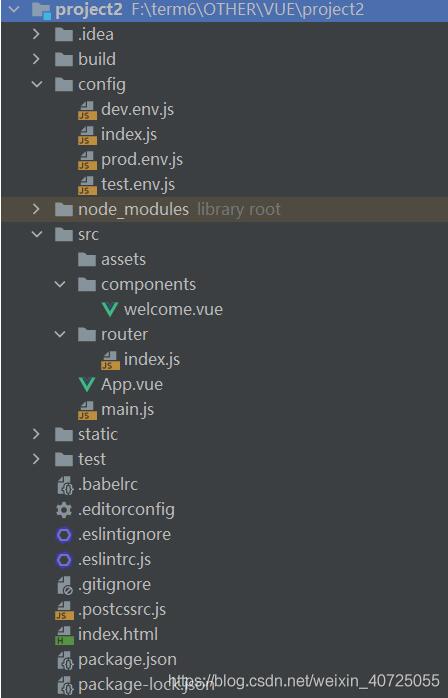springboot+VUE實現登錄註冊
本文實例為大傢分享瞭springboot+VUE實現登錄註冊的具體代碼,供大傢參考,具體內容如下
一、springBoot
創建springBoot項目
分為三個包,分別為controller,service, dao以及resource目錄下的xml文件。
UserController.java
package springbootmybatis.controller;
import org.springframework.web.bind.annotation.CrossOrigin;
import org.springframework.web.bind.annotation.PostMapping;
import org.springframework.web.bind.annotation.RequestBody;
import org.springframework.web.bind.annotation.RestController;
import springbootmybatis.pojo.User;
import springbootmybatis.service.UserService;
import javax.annotation.Resource;
@RestController
public class UserController {
@Resource
UserService userService;
@PostMapping("/register/")
@CrossOrigin("*")
String register(@RequestBody User user) {
System.out.println("有人請求註冊!");
int res = userService.register(user.getAccount(), user.getPassword());
if(res==1) {
return "註冊成功";
} else {
return "註冊失敗";
}
}
@PostMapping("/login/")
@CrossOrigin("*")
String login(@RequestBody User user) {
int res = userService.login(user.getAccount(), user.getPassword());
if(res==1) {
return "登錄成功";
} else {
return "登錄失敗";
}
}
}
UserService.java
package springbootmybatis.service;
import org.springframework.stereotype.Service;
import springbootmybatis.dao.UserMapper;
import javax.annotation.Resource;
@Service
public class UserService {
@Resource
UserMapper userMapper;
public int register(String account, String password) {
return userMapper.register(account, password);
}
public int login(String account, String password) {
return userMapper.login(account, password);
}
}
User.java (我安裝瞭lombok插件)
package springbootmybatis.pojo;
import lombok.Data;
@Data
public class User {
private String account;
private String password;
}
UserMapper.java
package springbootmybatis.dao;
import org.apache.ibatis.annotations.Mapper;
@Mapper
public interface UserMapper {
int register(String account, String password);
int login(String account, String password);
}
UserMapper.xml
<?xml version="1.0" encoding="UTF-8" ?>
<!DOCTYPE mapper
PUBLIC "-//mybatis.org//DTD Mapper 3.0//EN"
"http://mybatis.org/dtd/mybatis-3-mapper.dtd">
<mapper namespace="springbootmybatis.dao.UserMapper">
<insert id="register">
insert into User (account, password) values (#{account}, #{password});
</insert>
<select id="login" resultType="Integer">
select count(*) from User where account=#{account} and password=#{password};
</select>
</mapper>
主幹配置
application.yaml
server.port: 8000
spring:
datasource:
username: root
password: 123456
url: jdbc:mysql://localhost:3306/community?serverTimezone=UTC&useUnicode=true&characterEncoding=utf-8
driver-class-name: com.mysql.cj.jdbc.Driver
mybatis:
type-aliases-package: springbootmybatis.pojo
mapper-locations: classpath:mybatis/mapper/*.xml
configuration:
map-underscore-to-camel-case: true
數據庫需要建相應得到表
CREATE TABLE `user` ( `account` varchar(255) COLLATE utf8_bin DEFAULT NULL, `password` varchar(255) COLLATE utf8_bin DEFAULT NULL ) ENGINE=InnoDB DEFAULT CHARSET=utf8 COLLATE=utf8_bin;
二、創建VUE項目
安裝node,npm,配置環境變量。
配置cnpm倉庫,下載的時候可以快一些。
npm i -g cnpm --registry=https://registry.npm.taobao.org
安裝VUE
npm i -g vue-cli
初始化包結構
vue init webpack project
啟動項目
# 進入項目目錄 cd vue-01 # 編譯 npm install # 啟動 npm run dev
修改項目文件,按照如下結構

APP.vue
<template>
<div id="app">
<router-view/>
</div>
</template>
<script>
export default {
name: 'App'
}
</script>
<style>
</style>
welcome.vue
<template>
<div>
<el-input v-model="account" placeholder="請輸入帳號"></el-input>
<el-input v-model="password" placeholder="請輸入密碼" show-password></el-input>
<el-button type="primary" @click="login">登錄</el-button>
<el-button type="primary" @click="register">註冊</el-button>
</div>
</template>
<script>
export default {
name: 'welcome',
data () {
return {
account: '',
password: ''
}
},
methods: {
register: function () {
this.axios.post('/api/register/', {
account: this.account,
password: this.password
}).then(function (response) {
console.log(response);
}).catch(function (error) {
console.log(error);
});
// this.$router.push({path:'/registry'});
},
login: function () {
this.axios.post('/api/login/', {
account: this.account,
password: this.password
}).then(function () {
alert('登錄成功');
}).catch(function (e) {
alert(e)
})
// this.$router.push({path: '/board'});
}
}
}
</script>
<style scoped>
</style>
main.js
// The Vue build version to load with the `import` command
// (runtime-only or standalone) has been set in webpack.base.conf with an alias.
import Vue from 'vue'
import App from './App'
import router from './router'
import ElementUI from 'element-ui'
import 'element-ui/lib/theme-chalk/index.css'
import axios from 'axios'
import VueAxios from 'vue-axios'
Vue.use(VueAxios, axios)
Vue.use(ElementUI)
Vue.config.productionTip = false
/* eslint-disable no-new */
new Vue({
el: '#app',
router,
components: {App},
template: '<App/>'
})
router/index.js
import Vue from 'vue'
import Router from 'vue-router'
import welcome from '@/components/welcome'
Vue.use(Router)
export default new Router({
routes: [
{
path: '/',
name: 'welcome',
component: welcome
}
]
})
config/index.js
'use strict'
// Template version: 1.3.1
// see http://vuejs-templates.github.io/webpack for documentation.
const path = require('path')
module.exports = {
dev: {
// Paths
assetsSubDirectory: 'static',
assetsPublicPath: '/',
proxyTable: {
'/api': {
target: 'http://localhost:8000', // 後端接口的域名
// secure: false, // 如果是https接口,需要配置這個參數
changeOrigin: true, // 如果接口跨域,需要進行這個參數配置
pathRewrite: {
'^/api': '' //路徑重寫,當你的url帶有api字段時如/api/v1/tenant,
//可以將路徑重寫為與規則一樣的名稱,即你在開發時省去瞭再添加api的操作
}
}
},
// Various Dev Server settings
host: 'localhost', // can be overwritten by process.env.HOST
port: 8080, // can be overwritten by process.env.PORT, if port is in use, a free one will be determined
autoOpenBrowser: false,
errorOverlay: true,
notifyOnErrors: true,
poll: false, // https://webpack.js.org/configuration/dev-server/#devserver-watchoptions-
// Use Eslint Loader?
// If true, your code will be linted during bundling and
// linting errors and warnings will be shown in the console.
useEslint: true,
// If true, eslint errors and warnings will also be shown in the error overlay
// in the browser.
showEslintErrorsInOverlay: false,
/**
* Source Maps
*/
// https://webpack.js.org/configuration/devtool/#development
devtool: 'cheap-module-eval-source-map',
// If you have problems debugging vue-files in devtools,
// set this to false - it *may* help
// https://vue-loader.vuejs.org/en/options.html#cachebusting
cacheBusting: true,
cssSourceMap: true
},
build: {
// Template for index.html
index: path.resolve(__dirname, '../dist/index.html'),
// Paths
assetsRoot: path.resolve(__dirname, '../dist'),
assetsSubDirectory: 'static',
assetsPublicPath: '/',
/**
* Source Maps
*/
productionSourceMap: true,
// https://webpack.js.org/configuration/devtool/#production
devtool: '#source-map',
// Gzip off by default as many popular static hosts such as
// Surge or Netlify already gzip all static assets for you.
// Before setting to `true`, make sure to:
// npm install --save-dev compression-webpack-plugin
productionGzip: false,
productionGzipExtensions: ['js', 'css'],
// Run the build command with an extra argument to
// View the bundle analyzer report after build finishes:
// `npm run build --report`
// Set to `true` or `false` to always turn it on or off
bundleAnalyzerReport: process.env.npm_config_report
}
}

輸入賬號密碼,實現簡單的註冊,登錄功能。
以上就是本文的全部內容,希望對大傢的學習有所幫助,也希望大傢多多支持WalkonNet。
推薦閱讀:
- SpringBoot MyBatis簡單快速入門例子
- spring boot寫java web和接口
- Vue註冊模塊與登錄狀態的持久化實現方法詳解
- Spring Dao層@Repository與@Mapper的使用
- 解讀Mapper與Mapper.xml文件之間匹配的問題